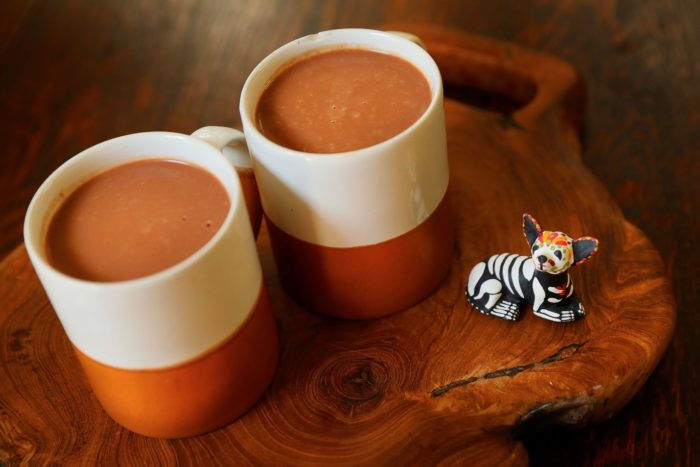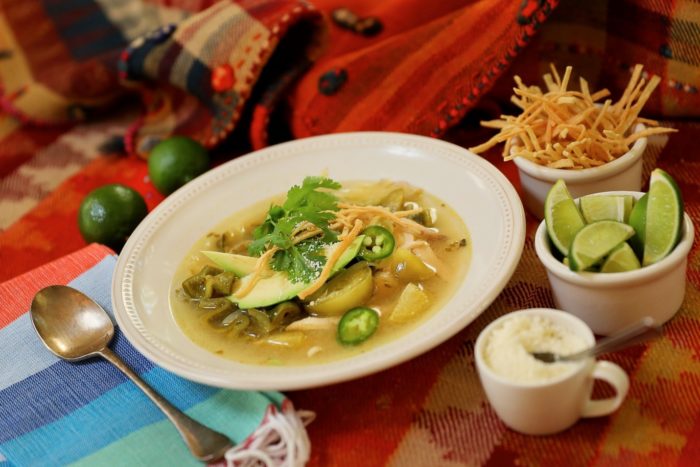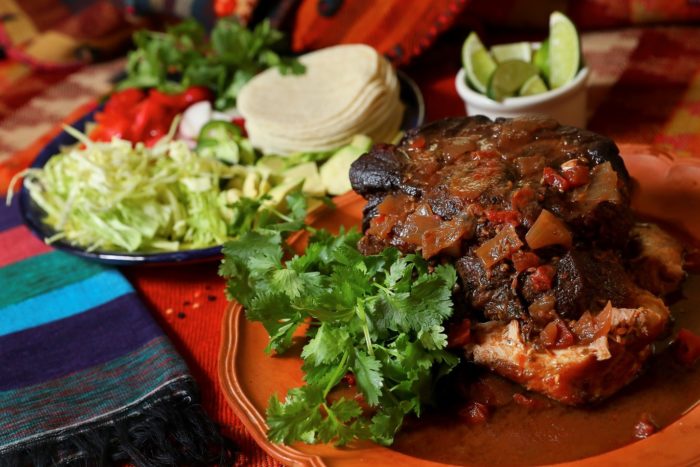We are just beginning to see in those fanciful sugar skulls and other reminders of Day of the Dead celebrations. In addition to the skulls, you’ll also see small tableaus, shadow boxes and folk-art figurines with skeletal characters often involved in hilarious poses.
The Day of the Dead ( Día de Muertos in Spanish) is a Mexican holiday celebrated throughout Mexico, most particularly in the Central and especially Southern regions. Usually celebrated on November 1 and 2, it coincides with the Catholic holiday of All Souls and All Saints Day as well as Halloween. It’s a much different celebration than Halloween however. Much more benign and not scary as Halloween often is. The indigenous people have combined this with their own ancient beliefs of honoring and remembering their deceased loved ones. They believe that the gates of heaven are opened at midnight on October 31, and the spirits of all deceased children (angelitos) can reunite with their families for 24 hours. On November 2, the spirits of the adults come down to enjoy the festivities and food that are prepared for them. In 2008, the tradition was recognized by UNESCO for its important cultural roots and heritage.
In most Indian villages, gorgeous altars (ofrendas) are made in each home. They are decorated with candles, buckets of flowers (wild marigolds called cempasuchil & bright red cock’s combs). You work up a mighty hunger and thirst traveling from the spirit world back to the realm of the living and so food is especially important. At least that’s the traditional belief in Mexico. Some families place their dead loved one’s favorite meal on a highly decorated altar or join graveside to share the meal with their departed ones. Altars additionally are piled high with fruit, peanuts, stacks of tortillas, sodas, hot cocoa and more. Toys and candies are left for the angelitos, and on Nov. 2, cigarettes and shots of mezcal are offered to the adult spirits.
It might begin with Atole . . . Mexican atole, is a hot drink made from corn and comes in a huge variety of flavors, from sweet to savory. Most traditional perhaps is this chocolate version known as champurrado, the corn-flavored base, made from masa harina, is enriched with dark chocolate and cinnamon for a warming, aromatic beverage that’s perfect for winter. I also love a peanut variation in which you substitute peanut butter for the chocolate. The amount of water and sugar added is up to you.
CHAMPURRADO
Serves 4 to 6
1/2 cup masa harina para tortillas such as Maseca brand
3 cups water plus more as needed
1 cup milk
3 1/2 ounces dark chocolate, broken into pieces
3 tablespoons dark brown sugar
1 cinnamon stick or 1/4 teaspoon ground cinnamon
Kosher salt
In a large saucepan, add masa and set over medium heat. Immediately add water in a slow, thin stream while whisking constantly to avoid lumps. Bring to a simmer and whisk in milk, chocolate, brown sugar, and a generous pinch of salt until chocolate is melted, about 1 minute. Add cinnamon.
Return to a simmer and lower heat to low. Continue to simmer gently, whisking constantly, for 5 minutes. Discard cinnamon stick, if using. Thin with additional water, as needed, to create a thick-yet-drinkable hot beverage, reheating as necessary. Taste, adding more sugar or salt if desired. Froth with a whisk or immersion blender, then ladle into mugs, and serve.

SOPA DE LIMA
(Mexican Chicken Soup with Lime)
Serves 8 or more
Typical of flavors found in the Yucatan.
Coconut or olive oil for frying
One 8-ounce package yellow or white corn tortillas sliced into strips 1/4 inch by 2 inches
1 whole chicken (about 3 pounds)
2 medium white onions, peeled, halved and sliced lengthwise
4 cloves garlic thinly sliced
2 medium fresh poblano peppers, stemmed, seeded and diced
1 teaspoon ground cumin
2 teaspoons oregano, preferably Mexican
1 teaspoon fennel seed
2 teaspoons pure chile powder such as ancho or 1/2 teaspoon chile flakes
3 cups or so quartered tomatillos
2 cups cooked long-grain white rice
Kosher salt and freshly ground pepper
5 large limes, 4 juiced and one cut into wedges for garnish
Accompaniments: Sliced jalapeños, cilantro sprigs, avocado slices, crumbled cotija cheese and
reserved tortilla strips
Line a plate with paper towels. Add an inch of oil to a deep sauce pan and over moderately high heat, fry the tortilla strips until crisp and golden brown, about 2 minutes. Using a spider or slotted spoon, transfer the tortilla strips to the towel-lined plate and let them cool.
Nestle the chicken in a large stock pot and pour enough water into the pot to cover the chicken by 2 inches. Bring the water to a gentle boil over medium-high heat and then immediately reduce the heat to medium-low, partially cover, and very gently simmer until the chicken is cooked through and the meat shreds easily with a fork, about 1-1/2 hours.
Remove the chicken from the pot and place on a plate to rest until it’s cool enough to handle. Remove and discard the skin. Pull the meat from the bone, discarding bones, shred or tear it and set aside.
Strain the cooking liquid through a fine-mesh sieve, discarding solids and set aside. Wipe out the pot, add 2 tablespoons of oil and over moderate heat, sauté the onions, garlic, poblano, cumin, oregano, fennel seed and chile until vegetables are softened, about 6 minutes. Add 6 cups or so of the stock, tomatillos, reserved chicken and simmer for 10 minutes more. Taste for seasoning and add salt, pepper, more chile powder and lime juice (at least 3 tablespoons) to your taste.
Add a scoop of rice to warm bowls and ladle soup over. Pass accompaniments separately and allow each guest to add to his or her bowl as desired.

ENCHILADAS SUIZAS CON HONGOS
(Mushroom Enchiladas in Tomatillo Cream Sauce)
Serves 4 – 6
This cheesy, creamy dish originated at a Sanborns cafe in Mexico City in 1950. Its name in English translates to “Swiss enchiladas,” and refers to its copious use of dairy. You could use chicken here too and I often make these with shrimp or crab meat if I’m feeling flush or the slow cooked pork recipe below.
1-1/2 pounds tomatillos, husks removed and rinsed (about 10)
2 medium poblano chiles, stemmed
2 large serrano chiles, stemmed
1 cup roughly chopped cilantro
1-1/2 cups sour cream or crème fraiche
1 teaspoon toasted and ground cumin seeds
4 cloves garlic roughly chopped and divided
Kosher salt and freshly ground black pepper, to taste
1 cup canola oil divided
I large white onion, peeled and chopped
1-pound mushrooms, coarsely chopped1 pound zucchini, chopped
1 teaspoon fennel seed crushed
2 teaspoons oregano, preferably Mexican
8 (6″) corn tortillas
2 – 3 cups shredded queso Oaxaca, jack or mozzarella cheese
Arrange an oven rack 4″ from the broiler and heat broiler to high. Place tomatillos, poblanos and serranos on a foil-lined baking sheet and broil, turning as needed, until blackened all over, about 10 minutes. Let cool and then peel and discard charred skins. Transfer to a blender along with any juices, cilantro, sour cream, cumin, half the garlic and 1 cup boiling water and purée until smooth. Season to taste with salt and pepper. Set enchilada sauce aside.
Heat 1/2 cup oil in a large pan over medium high heat, add the onions and cook until tender, about 6 minutes. Add the mushrooms and cook until they release their juices moisture and it has evaporated, about 10 minutes. Add the zucchini and cook until just tender about 4 minutes. Add the remaining garlic, fennel seed and oregano and cook until fragrant, about 2 minutes. Stir in 1 cup or so enchilada sauce and set aside.
Heat remining oil in a 12″ skillet over medium heat. Working in batches, grasp tortillas with tongs and fry in oil until pliable, about 30 seconds. Transfer tortillas to a work surface. Divide sauced mushrooms evenly among tortillas and roll tightly. Pour about 1 cup enchilada sauce in the bottom of a 9″ x 13″ baking dish, and place tortilla rolls in dish, seam side down, creating one row down the center of the dish. Pour remaining enchilada sauce over rolls and cover evenly with cheese.
Heat oven to 375°. Bake enchiladas until sauce is bubbling and cheese is melted and lightly browned on top, 20 minutes or so. Remove from oven and let cool for a few minutes before serving.
PALETA DE CERDO
(Slow cooked Mexican style pork shoulder)
Serves 8 – 10
Slow, long cooking is the key to making this dish meltingly tender. Shred or chop the meat with its juices and then roll up in warm tortillas along with shredded cabbage, chopped avocadoes, tomatoes, sweet white onion, some cilantro leaves and lime wedges to squeeze juice over. If you own a crock pot this is a great recipe for this useful appliance. You can also serve with rice and/or black beans.
3 tablespoons olive oil
5 pounds or so bone in pork shoulder
Salt and freshly ground pepper
2 large onions chopped (about 3 cups)
8 large cloves garlic peeled and chopped
2 tablespoons chopped chipotle chile in adobo, or to taste
2 cups diced canned or fresh tomatoes
1 tablespoon crushed cumin seeds
2 teaspoons whole fennel seed
1/2 teaspoon ground cinnamon
1 tablespoon dried oregano, preferably Mexican
3 cups hearty red wine
1-1/2 cups orange juice
2 tablespoons brown sugar
Accompaniments:
Tortillas, shredded cabbage, lime wedges, chopped tomatoes, chopped avocados, cilantro leaves, sliced radishes, cooked beans and whatever else you might like
In a deep pot or Dutch oven with a cover, add the olive oil and heat over moderately high heat. Season the pork liberally with salt and freshly ground pepper and sear on all sides until nicely browned, about 10 minutes. Remove pork and pour off all but 2 tablespoons of fat.
Add the onions and garlic to pot and sauté over moderate heat until lightly browned. Add remaining ingredients and bring to a simmer, stirring to combine. Add pork back to pot, cover a place in a preheated 325-degree oven for 3 hours or until meat is very tender and falls easily off the bone.
Remove meat, discarding bone, to a serving bowl and cover with foil to keep warm. Allow braising liquid to sit at room temperature to facilitate removal of fat and remove and discard as much as you can from the surface. Strain defatted juices if desired, pushing down on solids and discarding them. You can also skip this step if you like yours a little more “rustic”. Return juices to pan and bring to a simmer and then pour over meat. Serve with accompaniments.

CHURROS
Makes 8 or so depending on the tip size
These fried, fluted fritters are a classic Mexican dessert. They are served hot, right out of the fat. Traditionally no sauce is used but I’ve included a very simple chocolate sauce in this recipe to dip the warm churros in. Sort of gilding the lily! For these you’ll need a cookie press or a pastry bag with a 5/8-inch star tip.
1 cup water
1 stick (1/2 cup) unsalted butter
1/2 teaspoon salt
1 tablespoon sugar, plus 2/3 cup more for rolling
1 cup all-purpose flour
4 whole eggs, at room temperature
2 teaspoons ground cinnamon
Canola or other vegetable oil for frying
Mexican chocolate sauce (recipe follows)
Heat water, butter, salt and sugar together in a saucepan until it boils. Add flour all at once and beat vigorously with a wooden spoon until smooth (about 2 minutes). Off heat, beat in eggs one at a time to make a smooth, shiny pastry. Let mixture cool in the pan.
Mix the 2/3 cup sugar and cinnamon together and spread over the bottom of a baking sheet.
Heat a heavy pan with 1 inch of vegetable oil to 375 degrees. Scoop the cooled dough into the cookie press or pastry bag and press out a 6-inch length of dough into the hot oil cutting off with a small knife. Cook until golden brown, turning occasionally, about 3 minutes. Drain on paper towels and let it cool a minute. Cut the first one open to check for doneness. Center should be soft but not doughy. Adjust oil temperature if necessary. Drain on paper towels and then roll in the cinnamon sugar. Serve immediately with warm Mexican chocolate sauce for dipping, if desired. If necessary, you can hold for a few minutes in a preheated 300-degree oven before serving.
MEXICAN CHOCOLATE SAUCE FOR DIPPING
Makes about 1 cup
Ibarra and Abuelita brand Mexican chocolates are widely available in Hispanic markets and many supermarkets. It’s traditionally used to make a hot chocolate drink.
2 three-ounce discs of Mexican chocolate
1/2 cup or so half and half
1 tablespoon dark rum
1/4 teaspoon Ancho or Chimayo Chile powder (optional)
Add all ingredients to a small stainless bowl and set over (but not on) a pan of simmering water to melt. Whisk to combine.
John Ash © 2018



